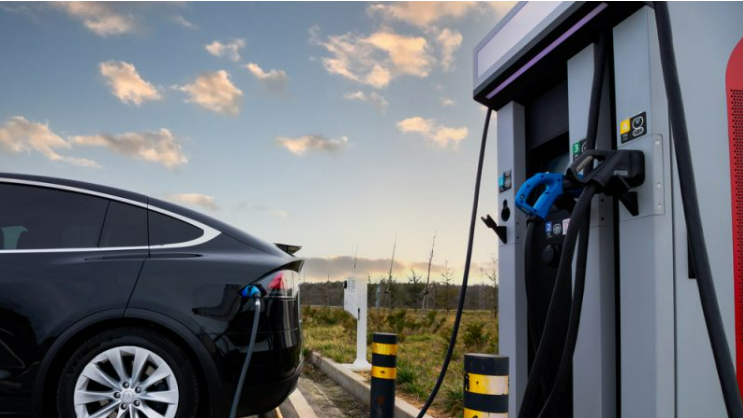European Union member states passed a law on Tuesday (25 July) to expand the EV charging infrastructure for e-cars in the European Union, marking a decisive step in the roll-out of e-mobility.
Until now, only a few countries have seen the development of charging points, a drive largely fuelled by private providers. This has cast a cloud over targets the EU must reach by 2050 and 2030 regarding installing fast-recharging stations along the bloc’s main transport corridors.
But on Tuesday, the Council of the EU, headed by Spain, adopted the Alternative Fuels Infrastructure Regulation (AFIR), which will be published in the EU’s official journal after the summer, coming into force twenty days later. On the ground, the new rules will apply six months after the entry into force date.
“The new law is a milestone of our ‘Fit for 55’ policy providing for more public recharging capacity on the streets in cities, and along the motorways across Europe,” Spain’s minister of Transport, Mobility and Urban Agenda Raquel Sánchez Jiménez said.
“We are optimistic that in the near future, citizens will be able to charge their electric cars as easily as they do today in traditional petrol stations.”
While consumers continue to be hesitant about going fully electric, the law is set to address the ‘chicken-and-egg’ issue of a low number of charging points leading to low consumer adoption, which, in turn, reduces demand for charging points.
But under the new rules, EU countries are now obliged to increase the number of charging stations for electric and hydrogen-powered vehicles and simplify the charging process.
More concretely, the newly adopted regulation obliges all EU states to provide charging stations at least every 60 kilometres on major roads from 2025.
Charging stations are also to be provided for trucks every 60 kilometres and hydrogen filling stations every 200 kilometres – but countries have longer to implement this.
The expansion of the charging infrastructure must run parallel to the expansion of e-mobility, with EU countries having to provide additional public charging capacity of 1.3 kilowatts (kW) per electric car sold. A reduced target of 0.8 kW applies per car sold with plug-in hybrid technology.
In a calculation for EURACTIV, the think tank International Council on Clean Transportation (ICCT) reckons this would mean approximately one additional charging point for every 33 electric cars sold.
The think tank said that if the International Energy Agency’s (IEA) projections for EV sales are reached, this would roughly equal a mandate of about 600,000 charging points in the EU by 2025. In 2022, the number of public charging points in the EU was around 450,000.
If an EU country hits the 15% mark on electric cars among the total stock, it can apply for a derogation. The share of e-cars compared to the overall stock is currently 2.3% in the EU.
Automotive industry views regulation as insufficient
The new law has already been reviewed positively by experts.
It is “a significant step forward in facilitating the transition to electromobility by addressing the long-standing chicken-and-egg problem in Europe’s charging infrastructure,” Felipe Rodríguez of the ICCT told EURACTIV.
Unlike other countries, the EU is not only setting non-binding targets but also legislating them, Rodríguez said.
“This blueprint can be inspiring for other countries and regions who struggle with securing the infrastructure rollout,” he added.
However, according to the automotive industry, the targets do not go far enough as it fears there will still not be sufficient available public charging points – and that buyers will thus shy away from switching to e-cars.
“Already today, a lack of charging and refuelling stations is severely hampering the market uptake of zero-emission vehicles “, said Sigrid de Vries, the head of the EU car lobby ACEA.
Even with the new targets, “a significant ‘infrastructure gap’ will continue to limit CO2 reductions and the transition of our sector to climate neutrality,” de Vries said in March.
According to the EU fleet limits for passenger cars, car manufacturers are obliged to increase the share of e-cars sold already by 2030 significantly – and to sell only zero-emission cars from 2035. If these targets are not met, fines may be imposed.
However, for fear the expansion would be very costly, EU member states resisted even higher targets for charging infrastructure. Among others, Germany subsidises expanding charging stations to the tune of billions of euros.
Only Poland and Romania voted against the new law in the final vote, while Italy and Latvia abstained. As all other EU states voted in favour of the new regulations, the required qualified majority was comfortably achieved.
Making payment easier
In addition to the minimum number of charging stations, the new law intends to solve another problem: charging point customers must often deal with complicated payment providers or subscription models.
In future, all public charging points in the EU must allow users to pay on an ad-hoc basis for which no subscription is needed. Fast charging stations over 50 kW must also have card readers to make card payments possible.
This will make charging stations “as easy to use as traditional petrol stations,” said EU lawmaker Petar Vitanov (S&D), who most recently took over the negotiations from his Social Democrat former colleague Ismail Ertug.
In addition to the charging infrastructure for electric cars, the law features other provisions, for example, on airports and seaports.
Post time: Nov-20-2023








